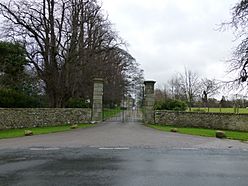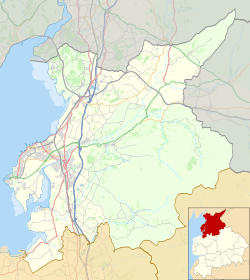Over Burrow Roman Fort facts for kids
Quick facts for kids Over Burrow Roman Fort |
|
|---|---|

Entrance to Burrow Hall
|
|
| Founded | c. 80 AD |
| Place in the Roman world | |
| Province | Britannia |
| Nearby water | River Lune |
| Structure | |
| — Stone structure — | |
| Built | c.3rd century |
| — Wood and earth structure — | |
| Built | c. 80 AD |
| Location | |
| Coordinates | 54°10′42″N 2°35′21″W / 54.1782°N 2.5892°W |
| Place name | Burrow-with-Burrow |
| Town | Lancaster |
| County | Lancashire |
| Country | England |
| Site notes | |
| Condition | Earthworks |
| Controlled by | Scheduled Monument |
Over Burrow Roman Fort is the modern name for an old Roman fort in Lancashire, North West England. It is located in a place called Burrow-with-Burrow. Today, an 18th-century country house, Burrow Hall, stands on the site.
The first Roman fort here was built around 80 AD. It was part of the Roman province of Britannia, which was the name for Britain when the Romans ruled it. We don't know the fort's original Roman name for sure. Some historians think it might have been Galacum or Alone. The modern name "Burrow" comes from an old English word meaning "fortified place," which makes sense for a fort!
Contents
History of the Roman Fort
Why the Romans Built a Fort Here
The Roman fort was probably built on a small hill. This spot was perfect because it was near where the River Lune meets a smaller stream called Leck Beck. This location helped the Romans control a river crossing.
The fort was also on an important Roman road that went up the Lune Valley from Lancaster. This road was key for moving soldiers and supplies.
Early Wooden Fort
Archaeologists believe the first fort built here was made of wood and earth. It was likely set up in the late 1st century AD. Not much is known about this early wooden fort.
Excavations have shown that the fort had ramparts (defensive walls made of clay and turf) and ditches. These defenses suggest there might have been a second period when this wooden fort was used.
Later Stone Fort
Later, probably in the late 3rd or early 4th century, a new fort was built. This time, it was made of stone. This stone fort was slightly different from the earlier wooden one.
The stone fort was shaped like a rectangle with rounded corners. It was about 143 meters (470 feet) long and 136 meters (445 feet) wide. This covered an area of about 1.9 hectares (4.75 acres).
Archaeologists have found the locations of the northern and southern gates. The eastern wall is thought to be under the current Burrow Hall. The stone from the fort walls was later taken and used for other buildings. However, the foundations, which were about 1.4 meters (4 feet 6 inches) wide, can still be traced.
Life Outside the Fort
Outside the fort walls, a small settlement grew. This was called a vicus. People who weren't soldiers, like traders and families, would have lived here. This settlement likely spread along the roads leading north and west from the fort.
Discoveries and Artifacts
Some interesting Roman artifacts have been found near the fort.
- Part of a Roman stone with carvings was found. It had messages dedicated to Roman gods of healing, Asclepius and Hygieia. This stone is now part of a window at St John the Baptist's Church, Tunstall.
- An altar (a stone used for religious offerings) dedicated to a local god named Contrebis was also reported. It was found in a nearby building that was taken down when Burrow Hall was built.
What We See Today
The area just south of the fort is still a bit of a mystery. There's a visible rampart next to the modern A683 road. This might have been part of an extra area for the fort or an even older camp.
In the 18th and 19th centuries, people thought the fort was located here. They believed that the southern part of the fort had been washed away by Leck Beck. However, excavations in the 1950s showed that a poorly built structure was added inside the fort's south gateway later on. This narrowed the entrance and might show the very last time the fort was used.
Today, Over Burrow Roman Fort is a protected site. It is known as a Scheduled Ancient Monument. This means it's an important historical place that is protected by law. Burrow Hall itself is also a Grade I listed building, meaning it's a very important historical building.



